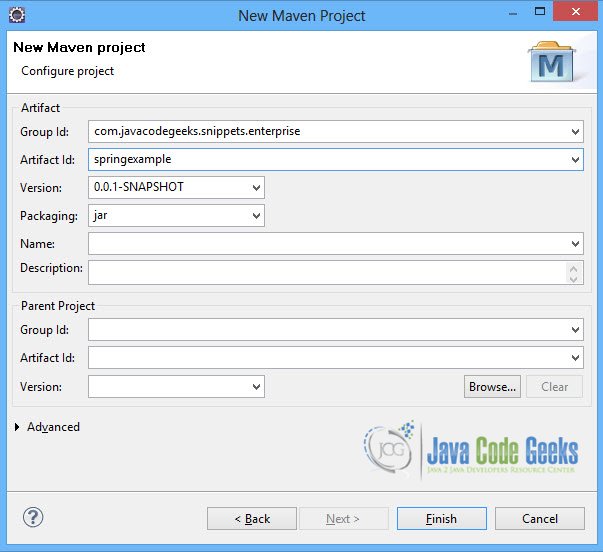Spring Bean Configuration Inheritance Example
This is a tutorial about the Configuration Inheritance between Spring Beans. In Spring, a bean definition can contain a lot of configuration information, including constructor arguments, property values, and container-specific information such as initialization method, static factory method name, and so on. A child bean definition is able to inherit configuration data from a parent definition. The child definition can override some values, or add others, as needed. Using parent and child bean definitions can save a lot of typing. Effectively, this is a form of templating.
An easy way for a bean to inherit another bean, is via the XML-configuration. The parent attritube can be used in the child bean definition inside the bean element, that will indicate the parent bean. Thus, the child bean can use the parent bean’s values and override them. Another way of bean inheritance is by using the abstract attribute to the parent bean definition, inside the bean element. In this way, the parent bean is a template that cannot be instantiated alone, but can be used by child beans and its values can also be overriden. We will check both ways.
Our preferred development environment is Eclipse. We are using Eclipse Juno (4.2) version, along with Maven Integration plugin version 3.1.0. You can download Eclipse from here and Maven Plugin for Eclipse from here. The installation of Maven plugin for Eclipse is out of the scope of this tutorial and will not be discussed. We are also using Spring version 3.2.3 and the JDK 7_u_21.
Let’s begin.
1. Create a new Maven project
Go to File -> Project ->Maven -> Maven Project.
In the “Select project name and location” page of the wizard, make sure that “Create a simple project (skip archetype selection)” option is checked, hit “Next” to continue with default values.
In the “Enter an artifact id” page of the wizard, you can define the name and main package of your project. We will set the “Group Id” variable to "com.javacodegeeks.snippets.enterprise" and the “Artifact Id” variable to "springexample". The aforementioned selections compose the main project package as "com.javacodegeeks.snippets.enterprise.springexample" and the project name as "springexample". Hit “Finish” to exit the wizard and to create your project.
The Maven project structure is shown below:
- It consists of the following folders:
- /src/main/java folder, that contains source files for the dynamic content of the application,
- /src/test/java folder contains all source files for unit tests,
- /src/main/resources folder contains configurations files,
- /target folder contains the compiled and packaged deliverables,
- the pom.xml is the project object model (POM) file. The single file that contains all project related configuration.
2. Add Spring 3.2.3 dependency
- Locate the “Properties” section at the “Overview” page of the POM editor and perform the following changes:
Create a new property with name org.springframework.version and value 3.2.3.RELEASE. - Navigate to the “Dependencies” page of the POM editor and create the following dependencies (you should fill the “GroupId”, “Artifact Id” and “Version” fields of the “Dependency Details” section at that page):
Group Id : org.springframework Artifact Id : spring-web Version : ${org.springframework.version}
Alternatively, you can add the Spring dependencies in Maven’s pom.xml file, by directly editing it at the “Pom.xml” page of the POM editor, as shown below:
pom.xml:
<project xmlns="http://maven.apache.org/POM/4.0.0"; xmlns:xsi="http://www.w3.org/2001/XMLSchema-instance"
xsi:schemaLocation="http://maven.apache.org/POM/4.0.0 http://maven.apache.org/xsd/maven-4.0.0.xsd">
<modelVersion>4.0.0</modelVersion>
<groupId>com.javacodegeeks.snippets.enterprise</groupId>
<artifactId>springexample</artifactId>
<version>0.0.1-SNAPSHOT</version>
<dependencies>
<dependency>
<groupId>org.springframework</groupId>
<artifactId>spring-core</artifactId>
<version>${spring.version}</version>
</dependency>
<dependency>
<groupId>org.springframework</groupId>
<artifactId>spring-context</artifactId>
<version>${spring.version}</version>
</dependency>
</dependencies>
<properties>
<spring.version>3.2.3.RELEASE</spring.version>
</properties>
</project>
As you can see Maven manages library dependencies declaratively. A local repository is created (by default under {user_home}/.m2 folder) and all required libraries are downloaded and placed there from public repositories. Furthermore intra – library dependencies are automatically resolved and manipulated.
3. Create a simple Spring Bean
The Animal.java class is a bean with three properties.
Animal.java:
package com.javacodegeeks.snippets.enterprise.services;
public class Animal {
private String colour;
private Long height;
private String name;
public String getColour() {
return colour;
}
public void setColour(String colour) {
this.colour = colour;
}
public Long getHeight() {
return height;
}
public void setHeight(Long height) {
this.height = height;
}
public String getName() {
return name;
}
public void setName(String name) {
this.name = name;
}
}
4. XML configuration for a child bean
First the animalBean is defined. Then the catBean is defined, using the parent attribute inside the <bean> element that shows its parent bean. The catBean inherits animalBean's properties and can also override them.
applicationContext.xml
<beans xmlns="http://www.springframework.org/schema/beans" xmlns:xsi="http://www.w3.org/2001/XMLSchema-instance" xmlns:p="http://www.springframework.org/schema/p" xmlns:aop="http://www.springframework.org/schema/aop" xmlns:context="http://www.springframework.org/schema/context" xmlns:jee="http://www.springframework.org/schema/jee" xmlns:tx="http://www.springframework.org/schema/tx" xmlns:task="http://www.springframework.org/schema/task" xsi:schemaLocation="http://www.springframework.org/schema/aop http://www.springframework.org/schema/aop/spring-aop-3.2.xsd http://www.springframework.org/schema/beans http://www.springframework.org/schema/beans/spring-beans-3.2.xsd http://www.springframework.org/schema/context http://www.springframework.org/schema/context/spring-context-3.2.xsd http://www.springframework.org/schema/jee http://www.springframework.org/schema/jee/spring-jee-3.2.xsd http://www.springframework.org/schema/tx http://www.springframework.org/schema/tx/spring-tx-3.2.xsd http://www.springframework.org/schema/task http://www.springframework.org/schema/task/spring-task-3.2.xsd"> <bean id="animalBean" class="com.javacodegeeks.snippets.enterprise.services.Animal"> <property name="name" value="animal"/> <property name="colour" value="white" /> <property name="height" value="15" /> </bean> <bean id="catBean" parent ="animalBean"> <property name="colour" value="black"/> <property name="name" value="cat" /> </bean> </beans>
4.1 Run the application
In the App.class we load both parent and child beans and get their properties.
App.java:
package com.javacodegeeks.snippets.enterprise;
import org.springframework.context.ApplicationContext;
import org.springframework.context.support.ClassPathXmlApplicationContext;
import com.javacodegeeks.snippets.enterprise.services.Animal;
public class App {
@SuppressWarnings("resource")
public static void main(String[] args) {
ApplicationContext context = new ClassPathXmlApplicationContext("applicationContext.xml");
Animal animal = (Animal) context.getBean("animalBean");
Animal cat = (Animal) context.getBean("catBean");
System.out.println(" Animal : " + animal.getName() + " " + animal.getColour() + " " + animal.getHeight());
System.out.println(" Cat : " + cat.getName() + " " + cat.getColour() + " " + cat.getHeight());
}
}
4.2 Output
The catBean has overriden the name and colour properties from animalBean, but has inherited the value of height property.
Animal : animal white 15
Cat : cat black 15
5. XML configuration using the abstract attribute in parent bean
The animalBean is now defined as an abstract. The catBean overrides again two properties from animalBean and inherits the third property, as shown below:
applicationContext.xml
<beans xmlns="http://www.springframework.org/schema/beans" xmlns:xsi="http://www.w3.org/2001/XMLSchema-instance" xmlns:p="http://www.springframework.org/schema/p" xmlns:aop="http://www.springframework.org/schema/aop" xmlns:context="http://www.springframework.org/schema/context" xmlns:jee="http://www.springframework.org/schema/jee" xmlns:tx="http://www.springframework.org/schema/tx" xmlns:task="http://www.springframework.org/schema/task" xsi:schemaLocation="http://www.springframework.org/schema/aop http://www.springframework.org/schema/aop/spring-aop-3.2.xsd http://www.springframework.org/schema/beans http://www.springframework.org/schema/beans/spring-beans-3.2.xsd http://www.springframework.org/schema/context http://www.springframework.org/schema/context/spring-context-3.2.xsd http://www.springframework.org/schema/jee http://www.springframework.org/schema/jee/spring-jee-3.2.xsd http://www.springframework.org/schema/tx http://www.springframework.org/schema/tx/spring-tx-3.2.xsd http://www.springframework.org/schema/task http://www.springframework.org/schema/task/spring-task-3.2.xsd"> <bean id="animalBean" abstract="true" > <property name="name" value="animal"/> <property name="colour" value="white" /> <property name="height" value="15" /> </bean> <bean id="catBean" parent ="animalBean" class="com.javacodegeeks.snippets.enterprise.services.Animal"> <property name="colour" value="grey"/> <property name="name" value="kitty" /> </bean> </beans>
5.1 Run the application
In the App.class we load the catBean and get its properties. Note that the animalBean cannot be instantiated now since it is explicitly marked as abstract. When a definition is abstract like this, it is usable only as a pure template bean definition that serves as a parent definition for child definitions. Trying to use such an abstract parent bean on its own, by referring to it as a ref property of another bean or doing an explicit getBean() call with the parent bean id, returns an error.
App.java:
package com.javacodegeeks.snippets.enterprise;
import org.springframework.context.ApplicationContext;
import org.springframework.context.support.ClassPathXmlApplicationContext;
import com.javacodegeeks.snippets.enterprise.services.Animal;
public class App {
@SuppressWarnings("resource")
public static void main(String[] args) {
ApplicationContext context = new ClassPathXmlApplicationContext("applicationContext.xml");
Animal cat = (Animal) context.getBean("catBean");
System.out.println(" Cat : " + cat.getName() + " " + cat.getColour() + " " + cat.getHeight());
}
}
5.2 Output
The catBean has overriden the name and colour properties from animalBean, but has inherited the value of height property.
Cat : kitty grey 15
This was an example of Spring Bean Configuration Inheritance.
Download the Eclipse project of this tutorial :
SpringBeanConfigurationInheritanceExample.zip







